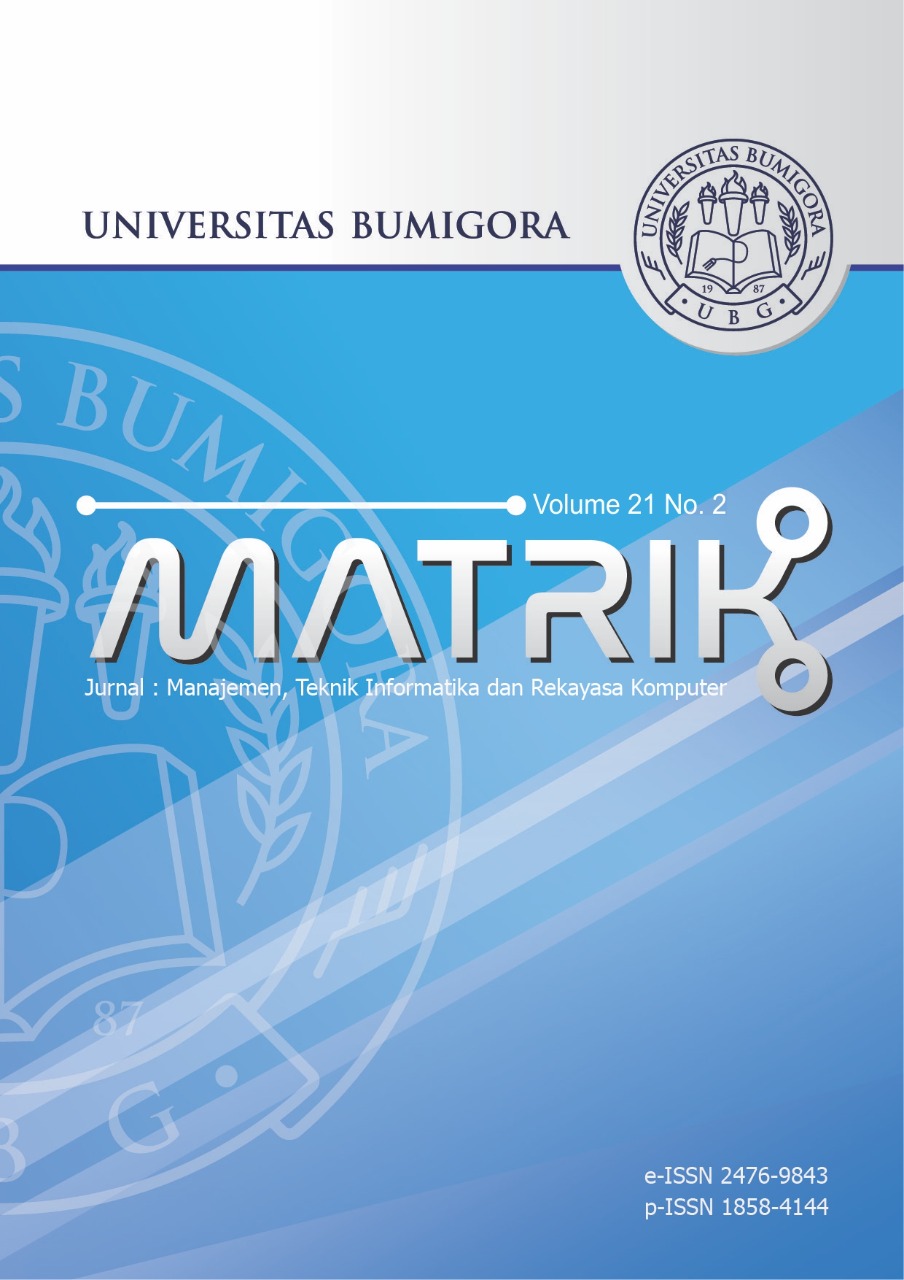Perancangan Platform Pengaduan Perundungan Berlandasarkan Bukti menggunakan Metode Agile
DOI:
https://doi.org/10.30812/matrik.v21i2.1547Keywords:
Bukti, Pengaduan, Perundungan, PlatformAbstract
Penelitian ini bertujuan untuk membuat sebuah platform pengaduan perundungan berlandaskan bukti yang terhubung dengan institusi terkait. Orang ketiga dapat menggunakan platform ini untuk melaporkan kejadian perundungan. Platform ini juga dapat digunakan untuk mengetahui kesehatan mental penggunanya. Platform memiliki fitur konsultasi dalam jaringan melalui fitur chat serta artikel edukasi psikologi dengan berbasis Progressive Web App. Laporan dapat dilakukan oleh korban ataupun pihak ketiga. Laporan perundungan akan masuk ke sekolah korban dan diproses melalui admin sekolah. Pelapor dapat memantau status dari kasusnya. Sekolah dapat merekap laporan kasus dalam rentang waktu tertentu. Pengujian telah dilakukan bersama siswa SMP dan SMA, guru BK, mahasiswa, bagian kemahasiswaan perguruan tinggi dan masyarakat umum. Pengujian dilakukan dengan peran admin institusi, admin pengaduan dan pengguna dengan total responden sebanyak 81 orang. Pengujian dilakukan terkait fungsional menggunakan blackbox test dan uji performa dari platform berdasarkan beberapa aspek. Berdasarkan pengujian yang telah dilakukan, platform ini sudah berfungsi dengan baik. Nilai rata-rata pengujian untuk semua fungsi adalah 351 dari maksimal 400 poin. Pengujian memberikan nilai rentang kelompok tinggi terhadap performa platform karena sudah sesuai dengan kebutuhan pengguna dan sudah memiliki tampilan yang mudah dimengerti, nyaman digunakan. Platform ini bisa menjadi alternatif solusi untuk menyelesaikan kasus perundungan terutama di sekitar kita.
Downloads
References
[2] S. Abuhammad, A. Alnatour, and K. Howard, “Intimidation and Bullying: A School Survey Examining the Effect of Demographic Data,†Heliyon, vol. 6, no. 7, p. e04418, 2020, doi: 10.1016/j.heliyon.2020.e04418.
[3] N. Hamel, S. Schwab, and S. Wahl, “Bullying: Group differences of being victim and being bully and the influence of social relations,†Stud. Educ. Eval., vol. 68, no. April 2020, p. 100964, 2021, doi: 10.1016/j.stueduc.2020.100964.
[4] UNESCO, “Behind the Numbers: Ending School Violence and Bullying,†2019. [Online]. Available: https://unesdoc.unesco.org/ark:/48223/pf0000366483.
[5] Y. Ding, D. Li, X. Li, J. Xiao, H. Zhang, and Y. Wang, “Profiles of Adolescent Traditional and Cyber Bullying and Victimization: The Role of Demographic, Individual, Family, School, and Peer Factors,†Comput. Human Behav., vol. 111, p. 106439, 2020, doi: 10.1016/j.chb.2020.106439.
[6] O. for E. C. OECD and Development, “PISA 2018 Results (Volume III) :What School Life Means for Student’s Lives,†vol. 3, 2019.
[7] I. S. Borualogo and E. Gumilang, “Kasus Perundungan Anak di Jawa Barat : Temuan Awal Children ’ s Worlds Survey di Indonesia,†vol. 6, pp. 15–30, 2019, doi: 10.15575/psy.v6i1.4439.
[8] D. Olweus and S. P. Limber, “Some Problems with Cyberbullying Research,†Curr. Opin. Psychol., vol. 19, no. 17, pp. 139–143, 2018, doi: 10.1016/j.copsyc.2017.04.012.
[9] R. M. Kowalski, G. W. Giumetti, A. N. Schroeder, and M. R. Lattanner, “Bullying in the Digital Age: A Critical Review and Meta-analysis of Cyberbullying Research among Youth,†Psychol. Bull., vol. 140, no. 4, pp. 1073–1137, 2014, doi: 10.1037/a0035618.
[10] G. Catone et al., “The Drawbacks of Information and Communication Technologies: Interplay and Psychopathological Risk of Nomophobia and Cyber-bullying, Results from the Bullying and Youth Mental Health Naples Study (BYMHNS),†Comput. Human Behav., vol. 113, no. November 2019, p. 106496, 2020, doi: 10.1016/j.chb.2020.106496.
[11] Komisi Perlindungan Anak Indonesia, “Hasil Survei Pemenuhan Hak {\&} Perlindungan Anak pada Masa Pandemi COVID-19,†2020.
[12] A. Calvo-Morata, C. Alonso-Fernández, M. Freire, I. MartÃnez-Ortiz, and B. Fernández-Manjón, “Creating Awareness on Bullying and Cyberbullying among Young People: Validating the Effectiveness and Design of the Serious Game Conectado,†Telemat. Informatics, vol. 60, 2021, doi: 10.1016/j.tele.2021.101568.
[13] T. Schoeler, L. Duncan, C. M. Cecil, G. B. Ploubidis, and J. B. Pingault, “Quasi-experimental evidence on short- and long-term consequences of bullying victimization: A meta-analysis,†Psychol. Bull., vol. 144, no. 12, pp. 1229–1246, 2018, doi: 10.1037/bul0000171.
[14] W. E. Copeland, D. Wolke, A. Angold, and E. J. Costello, “Adult Psychiatric Outcomes of Bullying and being Bullied by Peers in Childhood and Adolescence,†JAMA Psychiatry, vol. 70, no. 4, pp. 419–426, 2013, doi: 10.1001/jamapsychiatry.2013.504.
[15] H. Gaffney, M. M. Ttofi, and D. P. Farrington, “What Works in Anti-bullying Programs? Analysis of Effective Intervention Components,†J. Sch. Psychol., vol. 85, no. September 2019, pp. 37–56, 2021, doi: 10.1016/j.jsp.2020.12.002.
[16] K. Peng et al., “Self-reported Rates of Abuse, Neglect, and Bullying Experienced by Transgender and Gender-Nonbinary Adolescents in China,†JAMA Netw. Open, vol. 2, no. 9, pp. 1–12, 2019, doi: 10.1001/jamanetworkopen.2019.11058.
[17] S. Duan et al., “Bullying victimization, bullying witnessing, bullying perpetration and suicide risk among adolescents: A serial mediation analysis,†J. Affect. Disord., vol. 273, no. April, pp. 274–279, 2020, doi: 10.1016/j.jad.2020.03.143.
[18] D. P. Farrington, “The Importance of Risk Factors for Bullying Perpetration and Victimization,†J. Pediatr. (Versão em Port., vol. 96, no. 6, pp. 667–669, 2020, doi: 10.1016/j.jpedp.2020.05.001.
[19] M. Eyuboglu et al., “Traditional School Bullying and Cyberbullying: Prevalence, the Effect on Mental Health Problems and Self-harm Behavior,†Psychiatry Res., vol. 297, no. June 2020, p. 113730, 2021, doi: 10.1016/j.psychres.2021.113730.
[20] D. Menin, A. Guarini, C. Mameli, G. Skrzypiec, and A. Brighi, “Was that (cyber)bullying? Investigating the operational definitions of bullying and cyberbullying from adolescents’ perspective,†Int. J. Clin. Heal. Psychol., vol. 21, no. 2, p. 100221, 2021, doi: 10.1016/j.ijchp.2021.100221.
[21] M. Zhao et al., “Association Among Maltreatment, Bullying and Mental Health, Risk Behavior and Sexual Attraction in Chinese Students,†Acad. Pediatr., vol. 21, no. 5, pp. 849–857, 2021, doi: 10.1016/j.acap.2020.11.024.
[22] H. G. Joo, I. Kim, S. R. Kim, J. L. V Carney, and S. S. J. Chatters, “Why Witnesses of Bullying Tell: Individual and Interpersonal Factors,†Child. Youth Serv. Rev., vol. 116, p. 105198, 2020, doi: 10.1016/j.childyouth.2020.105198.
[23] D. Marengo, M. A. Fabris, L. E. Prino, M. Settanni, and C. Longobardi, “Student-Teacher Conflict Moderates the Link Between Student’s Social Status in the Classroom and Involvement in Bullying Behaviors and Exposure to Peer Victimization,†J. Adolesc., vol. 87, no. February, pp. 86–97, 2021, doi: 10.1016/j.adolescence.2021.01.005.
[24] F. Williams and D. G. Cornell, “Student Willingness to Seek Help for Threats of Violence in Middle School,†J. Sch. Violence, vol. 5, no. 4, pp. 35–49, 2006, doi: 10.1300/J202v05n04_04.
[25] A. Midgett, D. M. Doumas, and A. D. Johnston, “Establishing School Counselors as Leaders in Bullying Curriculum Delivery,†Prof. Sch. Couns., vol. 21, no. 1, 2017, doi: 10.1177/2156759x18778781.
[26] “Kids Helpline | Phone Counselling Service | 1800 55 1800.†https://kidshelpline.com.au/ (accessed Jan. 13, 2022).
[27] “Get Help Now | StopBullying.gov.†https://www.stopbullying.gov/resources/get-help-now (accessed Jan. 13, 2022).
[28] C. C. Silva and A. Goldman, “Agile methods adoption on software development: A pilot review,†Proc. - 2014 Agil. Conf. Agil. 2014, pp. 64–65, 2014, doi: 10.1109/AGILE.2014.14.
[29] Z. Kaprocki, V. Pekovic, and G. Velikic, “Combined testing approach: Increased efficiency of black box testing,†2015 IEEE 1st Int. Work. Consum. Electron. - Novi Sad, CE WS 2015, pp. 76–78, 2017, doi: 10.1109/CEWS.2015.7867160.
[30] M. Rahardi and A. Aminuddin, “Rancang Bangun Aplikasi Smart Touring Berbasis Android,†MATRIK J. Manajemen, Tek. Inform. dan Rekayasa Komput., vol. 21, no. 1, pp. 159–168, 2021, doi: 10.30812/matrik.v21i1.1185.
[31] E. T. Sihotang and H. Yutanto, “Tata Kelola Organisasi Mahasiswa Melalui Pengembangan Sistem Informasi,†MATRIK J. Manajemen, Tek. Inform. dan Rekayasa Komput., vol. 21, no. 1, pp. 99–110, 2021, doi: 10.30812/matrik.v21i1.1391.
Downloads
Published
Issue
Section
How to Cite
Similar Articles
- Deni Marta, M. Angga Eka Putra, Guntoro Barovih, Analisis Perbandingan Performa Virtualisasi Server Sebagai Basis Layanan Infrastructure As A Service Pada Jaringan Cloud , MATRIK : Jurnal Manajemen, Teknik Informatika dan Rekayasa Komputer: Vol. 19 No. 1 (2019)
- Romi Choirudin, Ahmat Adil, Implementasi Rest Api Web Service dalam Membangun Aplikasi Multiplatform untuk Usaha Jasa , MATRIK : Jurnal Manajemen, Teknik Informatika dan Rekayasa Komputer: Vol. 18 No. 2 (2019)
- Siti Sauda, Eka Puji Agustini, Implementasi Prototype Model dalam Pengembangan Aplikasi Smart Cleaning Sebagai Pendukung Aplikasi Smart City , MATRIK : Jurnal Manajemen, Teknik Informatika dan Rekayasa Komputer: Vol. 20 No. 1 (2020)
- Gustin Setyaningsih, Hera Fitra, Hanun Karomatunnisa, Palupi Pandanarum, Aplikasi Monitoring Laporan Aduan Masyarakat pada Desa Kedunggede Kecamatan Lumbir , MATRIK : Jurnal Manajemen, Teknik Informatika dan Rekayasa Komputer: Vol. 20 No. 1 (2020)
- Baiq Rima Mozarita Erdiani, Aryo Yudo Husodo, Ida Bagus Ketut Widiartha, Novel Application of K-Means Algorithm for Unique Sentiment Clustering in 2024 Korean Movie Reviews on TikTok Platform , MATRIK : Jurnal Manajemen, Teknik Informatika dan Rekayasa Komputer: Vol. 24 No. 2 (2025)
- Moh.Erwin Indrawan, Ahmat Adil, IMPLEMENTASI RESTFUL WEB SERVICE ONE CHIP MULTI-CLIENT UNTUK MENGOPTIMALKAN PENJUALAN PULSA ALL OPERATOR , MATRIK : Jurnal Manajemen, Teknik Informatika dan Rekayasa Komputer: Vol. 15 No. 2 (2016)
- Khaerul Yasin, Ahmat Adil, Implementasi Google Maps API Pemetaan Jalur Evakuasi Bencana Alam di Kabupatem Lombok Utara , MATRIK : Jurnal Manajemen, Teknik Informatika dan Rekayasa Komputer: Vol. 19 No. 1 (2019)
- sri suharti, Anton Yudhana, Imam Riadi, Forensik Jaringan DDoS menggunakan Metode ADDIE dan HIDS pada Sistem Operasi Proprietary , MATRIK : Jurnal Manajemen, Teknik Informatika dan Rekayasa Komputer: Vol. 21 No. 3 (2022)
- Dedi Setiadi, Yogi Isro Mukti, Electronic Tourism Using Decision Support Systems to Optimize the Trips , MATRIK : Jurnal Manajemen, Teknik Informatika dan Rekayasa Komputer: Vol. 23 No. 1 (2023)
- Imam Fahrur Rozi, Ahmadi Yuli Ananta, Endah Septa Sintiya, Astrifidha Rahma Amalia, Yuri Ariyanto, Arin Kistia Nugraeni, Analyzing the Application of Optical Character Recognition: A Case Study in International Standard Book Number Detection , MATRIK : Jurnal Manajemen, Teknik Informatika dan Rekayasa Komputer: Vol. 24 No. 2 (2025)
You may also start an advanced similarity search for this article.


.png)












